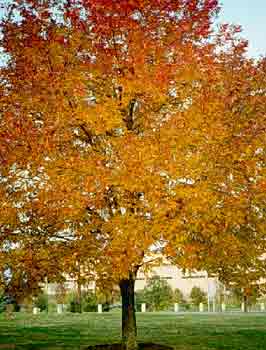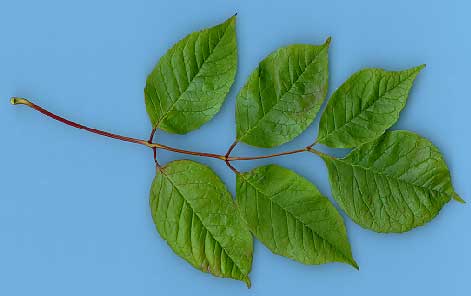 White Ash - Fraxinus americana
White Ash - Fraxinus americana
Olive Family (Oleaceae)
The most common ash in Kentucky is the white ash. It occurs in all parts of the state in woodland settings. The wood is very strong and used for a variety of uses including baseball bats and garden handles. The Kentucky champion tree is in Greenup County and is 125 feet tall.
- Native habitat: Nova Scotia to Minnesota, south to Texas and Florida.
- Growth habit: Upright in its youth, this tree becomes open and rounded with age.
- Tree size: Reaches a height of 50 to 80 feet with a similar spread at maturity. Can reach 120 feet tall.
- Flower and fruit: Clusters of small male and female flowers bloom on separate plants before leafout. Fruit is a tan, 1- to 2-inch-long samara.
- Leaf: White ash has a very large 8- to 15-inch leaf with five to nine leaflets. Dark green leaves become yellow and/or deep purple and maroon in fall.
- Hardiness: Winter hardy to USDA Zone 4.
- ‘Autumn Applause' - A seedless male with maroon fall color.
- ‘Autumn Blaze' - A female tree selected for purple fall color and light fruit set.
- ‘Autumn Purple' - This seedless male has deep green leaves that become purple and yellow in fall. Fall color may last two to four weeks.
- ‘Rosehill' - A seedless male selected for its dark green foliage that turns bronze-red in the fall. This cultivar is tolerant of lime soil.
 Additional information:
Additional information:White ash is abundant and familiar both in the woods and in the urban landscape. It is the most common of all ash species in its native range. The 95-foot national champion is in Palisades, N.Y. Although a tough, urban-tolerant tree, white ash is not as adaptable as green ash. Its ornamental qualities, however, exceed those of green ash, and white ash is much less likely to suffer storm and ice damage.
White ash seed attracts several bird species, including finches, cardinals, grosbeaks, grouse, turkey and quail.
The white ash genus name, Fraxinus, is from the Latin name for the Old World ash species. Ash belongs to the olive family and consequently has some unlikely relatives such as forsythia, privet, fringetree, lilac and olive. Fraxinus includes many economically important species because of its beautiful and useful wood. Its prized wood is strong and resilient but light in weight.
Because of its tremendous significance as a timber tree, ash has a well-developed Old World history and is incorporated into many ancient mythologies. The tree was thought to have the power to ward off snakes. When colonists arrived in the New World they quickly discovered wood of the New World ash species had the same superior qualities as that of the Old World ash species.
Of the North American ash species, white ash is the most valuable. Ash is used to make sports equipment (such as baseball bats and bowling alleys), tool handles and church pews. Its wood is also valued for making veneer and furniture.



